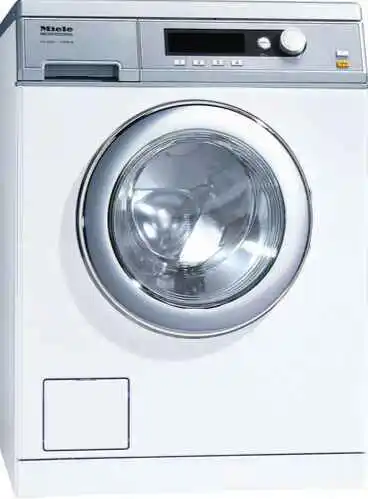Miele PW 6055 Washer User Manual (Free PDF) : Safety Instructions & Technical Data
The Miele PW 6055 washer manual provides detailed guidance for operating a high-performance industrial machine designed to combine durability, efficiency, and advanced technology. Tailored for commercial settings with heavy daily washing demands, this manual outlines how to use intelligent load control systems and customizable wash programs that optimize cleaning while conserving water and energy. With a long-lasting stainless steel drum and low maintenance requirements, every part is built to perform reliably under continuous use. This user manual is an essential tool for achieving consistent, professional-grade results with the Miele model.
Manual
This model falls under the category of washing machines. You’re free to download the User Manual PDF without any cost. This manual is available in English.
Do you have any questions regarding this model (WTW5000DW2)? Go directly to the support option in the header. I will provide the information within 24 hours.
Miele PW 6055 Safety Instructions
Operating the Miele PW 6055 requires strict adherence to safety protocols to maintain machine longevity and prevent potential hazards. First, the operation should only be performed by professionally trained personnel. Second, always ensure the power supply is connected in a dry and secure environment. Third, unplug the machine before performing any kind of maintenance or service. Fourth, use only the manufacturer-recommended detergent according to the specified guidelines.
Avoid overloading, as it can reduce efficiency and cause internal strain. Ventilation systems must be inspected regularly to prevent overheating. Lastly, understanding and using the emergency stop function when required is essential for safe operation. Following these safety instructions ensures optimal performance and reliable, hazard-free use of the Miele PW 6055.
Miele PW 6055 Washer Technical Data
Built to meet the demands of high-capacity laundry environments, this model PW 6055 combines industrial-strength engineering with long-term operational reliability. However, ensuring safe and efficient operation requires strict adherence to specific safety protocols. This guide provides a comprehensive explanation of the Miele laundry applaince safety instructions, tailored for engineers, facility managers, and commercial laundry operators.
Fire, Electrical, and Injury Risk Prevention
Operating any high-powered electrical appliance carries inherent risks. To minimize hazards such as electric shock, fire, or personal injury, certain baseline precautions must be observed.
Electrical Grounding and Power Supply Standards
Proper grounding of the Miele PW 6055 washer is not optional—it is critical. In the event of a fault, grounding routes the electrical current safely, preventing severe shocks.
Installation Environment Precautions
- Never install the washer in locations where temperatures fall below freezing. Frozen water lines can rupture, and electronic components may malfunction.
- Avoid exposure to outdoor weather. Moisture ingress can permanently damage the machine.
- The appliance is not rated for marine environments, RVs, or aircraft without explicit approval from Miele Technical Services.
Child Safety and Operational Warnings
Commercial machines pose significant danger if misused—particularly around children.
- Supervision is mandatory in environments where minors may access the appliance.
- The door must always remain closed during operation. Children can become trapped inside the drum, leading to fatal outcomes.
- Drum glass surfaces can become extremely hot during high-temperature cycles. Contact can cause severe burns, especially for unsupervised children.
Maintenance, Servicing, and Repairs
Safe operation extends beyond daily usage into periodic maintenance and repairs.
- Do not perform unauthorized repairs or modifications. Only certified technicians should replace components.
- Always disconnect the washer from the main power supply before performing maintenance. This is achieved by switching off the circuit breaker or unplugging the unit.
- Regular monitoring of inlet hoses is critical to ensure safety and performance. Any signs of damage, brittleness, or leaks should prompt immediate replacement using only genuine Miele parts.
- If the power cord is compromised, only a Miele-certified technician should perform the replacement to avoid fire risk or electrocution.
Hydrogen Gas Hazard Warning
Under certain conditions—particularly in systems where hot water has not been used for over two weeks—hydrogen gas may accumulate. This gas is highly explosive.
- In cases where the hot water supply has not been used for an extended period (typically two weeks or more), all hot water outlets should be opened fully to purge any trapped hydrogen gas before the washer is operated.
- Open flames, smoking, or electrical devices must be strictly avoided during this purging process.
Decommissioning and Disposal Safety
Before service removal or appliance disposal, the drum door must be taken off. This prevents entrapment accidents, especially in environments frequented by children or pets.
Technical Specifications Table
| Specification | Details |
|---|---|
| Height | 33 7/16″ (85 cm) |
| Width | 23 7/16″ (59.5 cm) |
| Depth (Closed Door) | 28 3/8″ (72 cm) |
| Depth (Door Open) | 44 1/8″ (112 cm) |
| Weight | 240 lbs (109 kg) |
| Maximum Floor Load | 613 lbs / 278 kg / 2778 N |
| Dry Laundry Capacity | 14.3 lbs (6.5 kg) |
| Fuse Rating | See unit’s data plate |
| Rated Load | See unit’s data plate |
| Noise Level During Spinning | < 70 dB(A) |
| Minimum Water Flow Pressure | 14.5 psi (1 bar) |
| Maximum Water Pressure | 145 psi (10 bar) |
| Intake Hose Length | 5’3″ (1.6 meters) |
| Power Cord Length | 5’3″ (1.6 meters) |
| Maximum Drain Height (Pump Assisted) | 3’3″ (1 meter) |
| Drum Lighting | Class 1 LED |

Conclusion:
In commercial laundry environments, the Miele PW 6055 washer delivers performance, efficiency, and durability. However, the machine’s complex electrical and mechanical systems demand respect. Strict compliance with safety protocols is not just best practice—it is essential to safeguard users, protect property, and ensure long-term operational integrity.
For organizations managing multiple units or operating in sensitive environments (hospitals, hotels, or manufacturing plants), it is strongly recommended to establish a standard operating procedure (SOP) based on Miele’s safety guidance.
